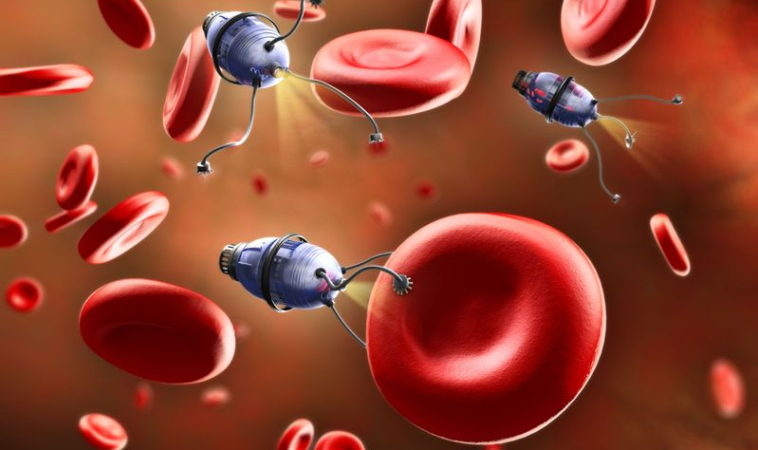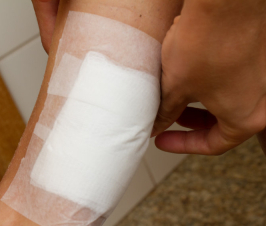Motorized Molecules with Major Effects
Nanomachines, microscopical molecules constructed to serve various functions, have incredible potential for different applications, including fighting cancer. A team of researchers are now working with nanomachines that can selectively infiltrate into cells and destroy them; they are controlled by light.1 Nanomachines are tiny nanomolecules that have tiny motors which allow them to move independently. In the case of the nanomachines used in this research (they are referring to them as nano-submarines), they are sensitive and able to be controlled by light.
Light Controlled Nano-Submarines
The idea is that by controlling the nano-submarines by using light, millions of healthy cells could be saved while delivering an effect to diseased cells specifically. The nano-submarines are much smaller than the cells themselves – about 50,000 of them can fit across the diameter of a human hair – and are able to pierce through the cell membrane and affect changes intracellularly.
Ultraviolet Light Lighting the Way
The study is a multidisciplinary project with scientists in biophysical research as well as electrical and computer engineering, chemistry and bioengineering departments from multiple different academic institutions. They developed a way to use ultraviolet light to spin a single-molecule nano-machine (the nano-submarine) between 2-3 million rotations per second, thus acting as a drill to penetrate through cellular membranes. The initial trials on prostate cancer cells took roughly 3 minutes to kill the cancer cells. The process of cellular death was able to be visualized through electron microscopy.
Microscopic Motors Received Nobel Prize for Chemistry in 2016
These microscopic motors received the Nobel prize for chemistry in 2016, lead researcher was Bernard Feringa. The application in medicine likely goes far beyond cancer treatment. Any cell could potentially be infiltrated and selective treatment delivered. The theory that DNA could be manipulated using this technology is on the table, and in fact there is a separate group of researchers attempting to build a nanodevice which would be able to accomplish this goal. Interesting times indeed.
Source
- Yan LB, Zhang QB, Zhu X, He M, Tang H. Serum S100 calcium binding protein A4 improves the diagnostic accuracy of transient elastography for assessing liver fibrosis in hepatitis B. Clin Res Hepatol Gastroenterol. 2017
Image Copyright: <a href=’https://www.123rf.com/profile_andreus’>andreus / 123RF Stock Photo</a>
 Node Smith, ND, is a naturopathic physician in Portland, OR and associate editor for NDNR. He has been instrumental in maintaining a firm connection to the philosophy and heritage of naturopathic medicine among the next generation of docs. He helped found the first multi-generational experiential retreat, which brings elders, alumni, and students together for a weekend camp-out where naturopathic medicine and medical philosophy are experienced in nature. Four years ago he helped found the non-profit, Association for Naturopathic ReVitalization (ANR), for which he serves as the board chairman. ANR has a mission to inspire health practitioners to embody the naturopathic principles through experiential education. Node also has a firm belief that the next era of naturopathic medicine will see a resurgence of in-patient facilities which use fasting, earthing, hydrotherapy and homeopathy to bring people back from chronic diseases of modern living; he is involved in numerous conversations and projects to bring about this vision.
Node Smith, ND, is a naturopathic physician in Portland, OR and associate editor for NDNR. He has been instrumental in maintaining a firm connection to the philosophy and heritage of naturopathic medicine among the next generation of docs. He helped found the first multi-generational experiential retreat, which brings elders, alumni, and students together for a weekend camp-out where naturopathic medicine and medical philosophy are experienced in nature. Four years ago he helped found the non-profit, Association for Naturopathic ReVitalization (ANR), for which he serves as the board chairman. ANR has a mission to inspire health practitioners to embody the naturopathic principles through experiential education. Node also has a firm belief that the next era of naturopathic medicine will see a resurgence of in-patient facilities which use fasting, earthing, hydrotherapy and homeopathy to bring people back from chronic diseases of modern living; he is involved in numerous conversations and projects to bring about this vision.

















